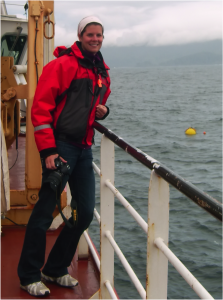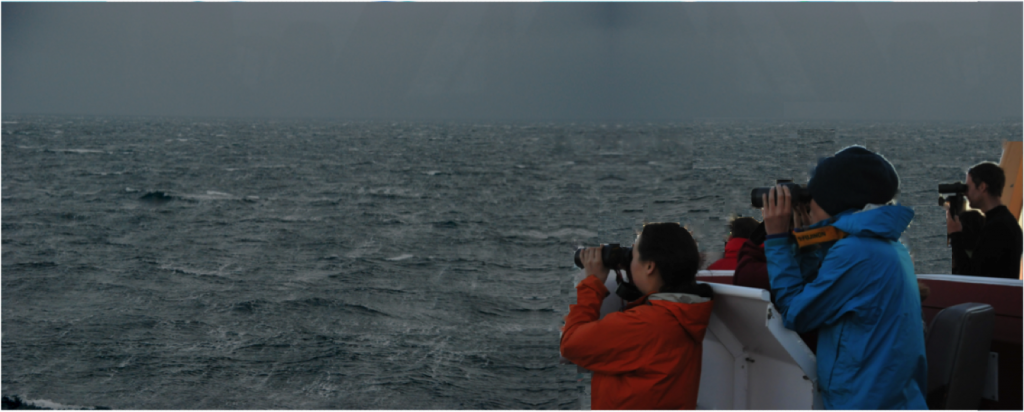Alumni
M.Sc 2015
E-mail: b.koot@oceans.ubc.ca
Supervisor: Dr. Andrew Trites, Dr. John Ford, David Hannay
Education: BSc. Biology, University of Victoria
Research Interests: Cetacean biology, ecology and acoustic communication, passive acoustic monitoring, automated detection and classification of cetacean calls, conservation
Research Area: Pacific Canadian waters
Research thesis:
Seasonal distribution and relative abundance of threatened and endangered whales in British Columbian waters, from passive acoustic data.
A number of large whale species occur in BC waters, many of which are legally listed under the Species at Risk Act (SARA). These include the blue (Endangered), fin (Threatened) humpback (Threatened), sei (Endangered) and North Pacific right whale (Endangered). These whales were the target of extensive commercial whaling in the 20th century, which reduced their population numbers dramatically. Due to their relative rarity, the large areas over which they range, and the difficulties associated with the monitoring of whales, there are many significant gaps in our knowledge of the current distributions, abundances and population structures of these whales.
Traditionally, field studies of large whales have involved ship-board and aerial visual surveys. However, the success of visual methods can be limited by cost, weather, sea-state, day-light hours, the sheer size of the area to be covered, and the fact that whales spend only a fraction of their time at the water’s surface where they can be observed visually.
Because of the limitations associated with visual methods, passive acoustic methods are becoming more popular around the world as a tool used for studying whale populations. Passive acoustic studies involve the use of hydrophones (underwater microphones) to record underwater sounds such as whale vocalizations. Hydrophone recording packages can be anchored to the sea floor where they can record data on a duty cycle for up to a full year. Passive acoustic methods are powerful because they collect long-term data at relatively low cost, and they have the ability to detect whales from great distances, at any time of day, and in any type of weather or sea-state. The species-specific nature of whale vocalizations allows species and even population level identification from passive acoustic data.
Research Questions:
What is the seasonal distribution, relative abundance, and population structure of threatened and endangered whales in British Columbian waters?
Approach:
I will be analyzing passive acoustic data collected from a network of Fisheries and Oceans Canada (DFO) autonomous hydrophone packages that are located throughout BC waters. It is currently standard practice to manually analyze acoustic data to extract whale vocalizations. However, due to the large amount of data that is typically collected from long-term passive acoustic studies, this is not a practical or cost-effective approach. Therefore, I will employ automatic detection and classification algorithms to detect whale vocalizations in the data. I will then undertake spatial and temporal analysis of the detected vocalizations, to examine seasonal distributions, migration patterns and relative abundance of whales in BC waters.

Spectrogram of humpback whale vocalizations.
Publications:
Technical Report
Ford, J.K.B., Koot, B., Vagle, S., Hall-Patch, N., and Kamitakahara, G. 2010. Passive acoustic monitoring of large whales in offshore waters of British Columbia. Canadian Technical Report of Fisheries and Aquatic Sciences 2898: vi + 30 p. (PDF)
Presentations and Posters
Koot B. 2013. Characterizing fin whale song in British Columbia for population structure analysis. Presentation at the 17th Northwest Student Chapter Meeting for the Society of Marine Mammalogy, Vancouver, BC, Canada.
Koot, B., Ford, J.K.B, Trites, A.W., and Hannay, D. 2013. Fin whales sing a consistent song in British Columbia. Poster at the Zoology Graduate Student Association Symposium. University of British Columbia, BC, Canada.
Koot B. 2012. Assessing fin whale population structure and seasonal distribution in British Columbia, using passive acoustics. Presentation at the 16th Northwest Student Chapter Meeting for the Society of Marine Mammalogy, Vancouver, BC, Canada.
Koot, B., Ford, J.K.B, Trites, A.W., and Hannay, D. 2012. Seasonal distribution, abundance and population structure of fin whales in British Columbia, Canada, using Passive Acoustics. Poster at SeaBass, Penn State University, Pennsylvania, USA.
Koot, B. 2012. The song of BC’s fin whales. Presentation at the BC Marine Mammal Symposium. University of British Columbia, Vancouver, BC, Canada.
Koot, B. 2011. Listening for endangered whales in British Columbia. Presentation at the BC Marine Mammal Symposium. Vancouver, BC
I appreciate the help and support provided by:


